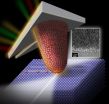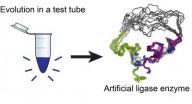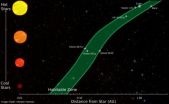(Press-News.org) PHILADELPHIA — Wear is a fact of life. As surfaces rub against one another, they break down and lose their original shape. With less material to start with and functionality that often depends critically on shape and surface structure, wear affects nanoscale objects more strongly than it does their macroscale counterparts.
Worse, the mechanisms behind wear processes are better understood for things like car engines than nanotech devices. But now, researchers at the University of Pennsylvania's School of Engineering and Applied Science have experimentally demonstrated one of the mechanisms behind wear at the smallest scale: the transfer of material, atom by atom, from one surface to another.
The research was conducted by Tevis Jacobs, a doctoral student in the Department of Materials Science and Engineering, and Robert Carpick, department chair of Mechanical Engineering and Applied Mechanics.
Their research was published in the journal Nature Nanotechnology.
On the nanoscale, wear is mainly understood through two processes, fracture and plastic deformation. Fracture is where large pieces of a surface break off at once, like when the point of a pencil snaps off in the middle of a sentence. Plastic deformation is what happens when the surface changes shape or compresses without breaking, like when the edge of knife gets dull or bent.
These mechanisms typically affect thousands or millions of atoms at a time, whereas nanoscale wear often proceeds through a much more gradual process. Determining the mechanisms behind this more gradual process is key to improving such devices.
"At the nanoscale, wear is a very significant problem," Jacobs says. "Nanotechnology is developing smaller and smaller parts for very tiny machines. Their contact interfaces wear out very quickly, sometimes surviving for hundreds of cycles when they need to survive for trillions or more."
One wear mechanism that had been hypothesized for the nanoscale is a process known as atomic attrition. There, atoms from one surface are transferred to the other surface via a series of individual bond-forming and bond-breaking chemical reactions. Other researchers have attempted to test this process by putting two surfaces in contact and sliding one against the other.
Those previous investigations involved Atomic Force Microscopes. Using an AFM involves dragging a very sharp tip mounted on a flexible cantilever over a surface while a laser aimed at the cantilever precisely measures how much the tip moves. By using the tip as one of the surfaces in a wear experiment, researchers can precisely control the sliding distance, sliding speed and load in the contact. But the AFM doesn't visualize the experiment at all; the volume of atoms lost from the tip can only be inferred or examined after the fact, and the competing wear mechanisms, fracture and plastic deformation can't be ruled out.
The Penn team's breakthrough was to conduct AFM-style wear experiments inside of a transmission electron microscope, or TEM, which passes a beam of electrons through a sample (in this case, the nanoscale tip) to generate an image of the sample, magnified more than 100,000 times.
By modifying a commercial mechanical testing instrument that works inside a TEM, the researchers were able to slide a flat diamond surface against the silicon tip of an AFM probe. By putting the probe-cantilever assembly inside the TEM and running the wear experiment there, they were able to simultaneously measure the distance the tip slid, the force with which it contacted the diamond and the volume of atoms removed in each sliding interval.
"We can watch the whole process live to see what happens while the surfaces are in contact," Jacobs said. "Then, after each pass, we use the TEM like a camera and take an even higher magnification picture of the tip. We can trace its outline and see how much volume has been lost, down to as small as 25 square nanometers, or about 1250 atoms.
"We are measuring changes in volume that are one thousand times smaller than can be seen using other techniques for wear detection."
While this new microscopy method can't image individual atoms moving from the silicon tip to the diamond punch, it enabled the researchers to see the atomic structure of the wearing tip well enough to rule out fracture and plastic deformation as the mechanism behind the tip's wear. Proving that the silicon atoms from the tip were bonding to the diamond and then staying behind involved combining the visual and force data into a mathematical test.
"If atomic attrition is what's happening," Carpick said, "then the rate at which those bonds are formed and the dependence on contact stress — the force per unit area — is well-established science. That means we can apply chemical kinetics, or reaction rate theory, to the wear process."
Now that they could measure the volume of atoms removed, the distance the tip slid and the force of the contact for each experimental test, the researchers could calculate the rate at which the silicon-diamond bonds form under different conditions and compare that to predictions based on reaction rate theory, a theory that is routinely used in chemistry.
"The more force the atoms are under, the more likely they are to form a bond with an atom on the opposing surface, so the wear rate should accelerate exponentially with additional stress," Jacobs said. "Seeing that in the experimental data was a smoking gun. The trend in the data implies that we can predict the rate of wear of the tip, knowing only the stress levels in the contact, as long as this wear mechanism is dominant."
For now, those predictions can only be made about the wear of silicon on diamond in a vacuum, though the selection of those two materials was not accidental. They are common in nanoscale devices and tools for nanomanufacturing.
The math behind the atomic attrition mechanism could eventually be applied in a fundamental way.
"The goal of this avenue of research is to get to the point where you tell me the materials in contact, and you tell me the period they are in contact and the stresses applied and I will be able to tell you the rate at which atoms will be removed," Jacobs said.
"With a fundamental understanding of wear, you can cleverly design surfaces and choose materials to make longer lasting devices," Carpick said.
This fundamental, predicative understanding of wear could vastly improve nanomechanical design, increasing functionality and decreasing costs.
INFORMATION:
The research was supported by the National Science Foundation's Nanomanufacturing Program and Penn's NanoBio Interface Center.
Penn research shows mechanism behind wear at the atomic scale
2013-01-30
ELSE PRESS RELEASES FROM THIS DATE:
Researchers improve medical units to reduce nursing fatigue, cut costs
2013-01-30
ITHACA, N.Y. – In hospitals, poor floor design, storage closet clutter and crowded corridors can contribute to nurse and medical staff fatigue. These distractions can hurt patient care quality and result in higher medical costs.
Now, a new Cornell University study offers a spatial solution.
Rana Zadeh, Cornell assistant professor of design and environmental analysis in the College of Human Ecology, analyzed the floor plans and work patterns within five medical-surgical units at U.S. hospitals and found numerous opportunities to boost nurses' efficiency through better ...
Conflicting cultural identities may foster political radicalism
2013-01-30
New research suggests that dual-identity immigrants — first-generation immigrants and their descendants who identify with both their cultural minority group and the society they now live in — may be more prone to political radicalism if they perceive their two cultural identities to be incompatible.
The new research is published in Psychological Science, a journal of the Association for Psychological Science.
Psychological scientist Bernd Simon from Kiel University in Germany and colleagues hypothesized that perceived incompatibility between the two cultural identities ...
Aging cells lose their grip on DNA rogues
2013-01-30
PROVIDENCE, R.I. [Brown University] — Even in our DNA there is no refuge from rogues that prey on the elderly. Parasitic strands of genetic material called transposable elements — transposons — lurk in our chromosomes, poised to wreak genomic havoc. Cells have evolved ways to defend themselves, but in a new study, Brown University researchers describe how cells lose this ability as they age, possibly resulting in a decline in their function and health.
Barbara McClintock, awarded the Nobel Prize in 1983, made the original discovery of transposons in maize. Since then ...
GEOLOGY starts 2013 with 25 new articles posted online ahead of print
2013-01-30
Boulder, Colo., USA - Geology content posted online 4 through 25 January 2013 cover topics from greenhouse gas emissions to video observations of erupting geysers in Russia and from the age of Earth to the age of Grand Canyon. Highlights and detailed information about each article are listed below.
1. Earth is mostly flat
2. Age maps of early Earth
3. Sagaing fault, Indo-Burmese wedge
4. Anthropogenic lead
5. The growth of a newly born submarine volcano
6. The Hemlo gold deposit, Ontario, Canada
7. Reptile and mammal fossils in the Karoo Basin, South Africa
8. ...
U. of Minn. researchers unveil first artificial enzyme created by evolution in a test tube
2013-01-30
There's a wobbly new biochemical structure in Burckhard Seelig's lab at the University of Minnesota that may resemble what enzymes looked like billions of years ago, when life on earth began to evolve – long before they became ingredients for new and improved products, from detergents to foods and fuels.
Seelig created the fledgling enzyme by using directed evolution in the laboratory. Working with colleague Gianluigi Veglia, graduate student Fa-An Chao, and other team members, he subsequently determined its structure, which made its debut December 9 as an advance online ...
Researchers develop model for identifying habitable zones around star
2013-01-30
UNIVERSITY PARK, Pa. -- Researchers searching the galaxy for planets that could pass the litmus test of sustaining water-based life must find whether those planets fall in a habitable zone, where they could be capable of having liquid water and sustaining life. New work, led by a team of Penn State researchers, will help scientists in that search.
Using the latest data, the Penn State Department of Geosciences team has developed an updated model for determining whether discovered planets fall within a habitable zone. The work builds on a prior model by James Kasting, ...
Reconcilable differences: Study uncovers the common ground of scientific opposites
2013-01-30
Searching for common elements in seemingly incompatible scientific theories may lead to the discovery of new ones that revolutionize our understanding of the world.
Such is the idea behind a mathematical framework Princeton University researchers developed that strips away the differences between scientific laws and theories to reveal how the ideas are compatible. In a recent report in the journal Physical Review Letters, the authors explain how the mathematical model finds common ground between the famously at-odds physics equations that govern classical and quantum ...
Mindfulness meditation heightens a listener's musical engagement
2013-01-30
EUGENE, Ore. -- (Jan. 30, 2013) -- When De'Anthony Thomas returned the opening kickoff for a touchdown in the 2013 Fiesta Bowl, says University of Oregon researcher Frank Diaz, Thomas put Ducks fans into a heightened zone of engagement for watching the game, not unlike what was experienced by music students who were first exposed to a brief session of mindfulness meditation before hearing an opera passage.
As a high school orchestra and band educator in Florida, Diaz had flirted with yoga and light meditation in a quest to heighten music engagement. He noticed, anecdotally, ...
Chronic kidney disease increases risk of death for both women and men
2013-01-30
A new study from the Johns Hopkins Bloomberg School of Public Health and the Chronic Kidney Disease Prognosis Consortium (CKD-PC) found that in general chronic kidney disease is similarly associated with a higher risk of death and end stage renal disease for both women and men. The findings were released online in advance of publication in BMJ.
Chronic kidney disease affects 10 to 16 percent of adults worldwide. Current thresholds for chronic kidney disease are based on two kidney measures, estimated glomerular filtration rate (GFR) and albuminuria, a measure of protein ...
Researchers help confirm value of flow-diverting device for most challenging aneurysms
2013-01-30
CINCINNATI—A multi-center study supports the effectiveness of the newest technology available for the treatment of difficult, life-threatening brain aneurysms. The technology, the Pipeline embolization device, is a flow diverter that redirects blood flow away from wide-necked or giant aneurysms that cannot be treated in more conventional ways.
Andrew Ringer, MD, director of the division of cerebrovascular surgery and professor of neurosurgery and radiology at the University of Cincinnati (UC) College of Medicine, led the Cincinnati portion of the study, which was published ...





